
| Return |
| • August 26 The forecast for next one week was cloudy or rainy but it turned out to be completely wrong. It became clear in the morning on September 27. I left home late at night on September 26 and arrived at the observatory at 23.00. I attempted to photograph C/2001 A2 LINEAR which was shining in the northern sky as well as a few other comets. I wondered about the nova in Cygnus discovered by Tago and turned the 60cm telescope to photograph it. Through the 20cm refractor (mounted on the 60cm) at 40x there was no particularly bright object visible. P/2001 Q2, in which I was interested, became a little fainter and was estimated to be 11.2 magnitude with the 20cm refractor at 60x. The coma was 2' in diameter and in photographs the sharp nucleus is at magnitude 13. At 4 in the morning I walked up the hill to search briefly very low altitude eastern skies with the 9cm comet seeker. I swept the sky horizontally starting at low altitudes and gradually moving up, the method used by Ikeya. One day you come across a bright new comet, and your life will change (Comet Seki 1961f). It's the essence of comet hunting. "With the spirit of comet hunting living in me my life is worth living." • August 20 • August 17 |
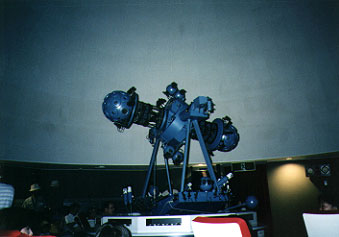 An old-type planetarium at Okayama Prefectural Astronomical Museum (Photo taken on August 4) |
| • August 16 I returned home from the observatory at 4 am, got out of the car, and looked toward the east and found a shiny spot attached to a thin crescent moon. I remembered that there was an occultation of Jupiter by the moon this morning. I went upstairs to pick up my 300mm telephoto lens and took a shot from the garden. It was exposed for 0.5 second at F4.5. Soon after this shot it was covered by clouds and there was no chance to see it again. The image turned out to be a little blurry because I didn't use a release cable. |
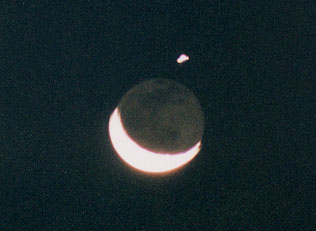 4 am August 16 Nikon F3 300mm F4.5 ISO 400 The original photo is trimmed to show its center. |
| • August 11 Cicadas sometimes become less noisy hinting at approaching autumn. But it is just a momentary pause and the daytime is hot as ever. It is still mid-summer. Mr. Kenichi Kadota from Kamio City, Saitama Prefecture, has returned to his parents' home and came to see me with Mr. Kenji Okamura, an old friend of mine. Mr. Kadota is a well-known figure as a "daring" comet observer leading troops of comet hunters. As you know, he has been making great contributions to comet observation using a 18cm equatorial telescope, which he acquired from Mr. Muraoka. He excels particularly in observation of comets at very low altitudes in twilight skies. I hear that Ageo City's sky is bright, but is it CCD's characteristic unlike photography that observation is possible even in light-polluted skies? Mr. Kadota observes and measures; Mr. Muraoka calculates orbits. They are a superbly matching combination. They will soon start their autumn season of their astronomical activity. |
 From left Mr. Kadota, Seki, and Mr. Muraoka (August 11, 2001) |
| • August 9 Boom! The loud noise echoes through the evening sky and fireworks exploded over Kochi City. This is the start of Yosakoi Matsuri Festival. Fireworks open the festival and lively street scenes with Naruko Odori dances continue for four days. I do not like noisy things even if they are pretty and I usually go to the observatory if the sky is clear. But last night I was lost in orbital calculations of comets. I saw fireworks on the veranda only once while they continued for three hours. I saw a lot of people passing by wearing Yukata (summer kimono). When the festival ends, the memorial day for the end of the war comes and goes, and the national high school baseball tournament is over, you will soon begin to feel autumn in the air. |
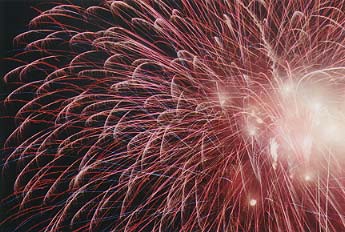 Fireworks taken from the upstairs of my home using 300mm telephoto lens with a one-minute exposure |
| • August 4 About forty of us, lecturers and students, from Geisei Observatory Astronomy Learning Center, visited Okayama Astrophysical Observatory. The observatory was established in 1957. Its 188cm reflector, Asia's largest, shows a sign of aging as 45 years have past since its installation. Prof. Koichi Tomita immediately photographed C/1961 T1 (Seki) which I had discovered in October 1961. I remember that his photograph displaying a huge coma was tacked on the ceiling of Tokyo Observatory's department for search for new astronomical objects. According to Prof. Michitoshi Yoshida, the Observatory Director, they are devoting themselves to detecting perturbation of distant stars to discover planets outside the solar system. Just like the Sun orbiting the center of gravity of the solar system, stars' perturbation can be detected by powerful telescopes. However, the 8m (Subaru) telescope at Hawaii is not suitable for this purpose, I was told. Prof. Yoshida said that this 188cm telescope, Asia's largest, was coming to the end of its life and to be replaced by Kyoto University's large 3m reflector. What will happen to the huge dome for the 188cm telescope? Prof. Yoshida indicated that there was a suggestion to convert it to an astronomical museum. It seems only yesterday that Prof. Koichiro Tomita had detected many periodical comets using this 188 cm reflector. I saw a photograph of Comet Ikeya-Seki in the dome. Indeed, forty-five years have passed since its discovery! To me it is almost a miracle that one of the co-discoverer is standing in the dome now. |
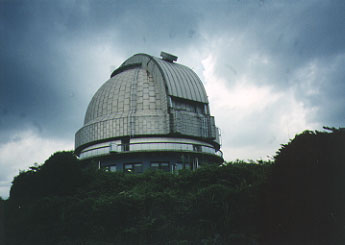 Okayama Astrophysical Observatory 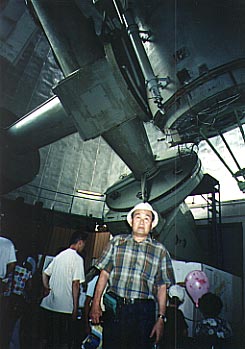 The 188cm telescope and I |
Copyright (C) 2001 Tsutomu Seki.